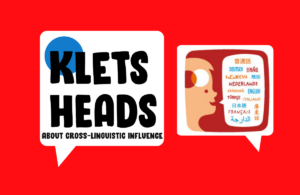Living in a modern globalised world, we face many challenges and try to get solutions. On that note, we wonder how bilingual children’s languages influence each other and get to know from Sharon Unsworth, a linguist at Radboud University, about this aspect.
“You’re wobbling the whole time the table!” This is what my bilingual son said to his sister when they were playing a board game sat together at a small table, and his big sister was also playing with the table leg. His message was clear. Big sister stopped, and the game continued. What struck me most about this conversation was how my son had chosen to phrase his statement: his sentence was perfectly ok English, and his sister clearly understood him, but his English-speaking cousins in England might have said that differently. They would have switched the words around and said, “You’re wobbling the table the whole time” instead. This is a wonderful example of what we call cross-linguistic influence. The way in which my son put together his sentence was clearly influenced by the fact that he speaks Dutch as well as English, because in Dutch, “de hele tijd” (the Dutch for “the whole time”) comes before “de tafel” (the Dutch for “the table”) and not after it. In short, cross-linguistic influence is a fancy term for how one language influences the other.
This phenomenon is often found in bilingual children or adults who learn a second language later in life. They sometimes say things in a slightly different way, and this is often related to how their other language works. Why do bilingual children do this? Why do some bilingual children do it more often than others? Is cross-linguistic influence something to worry about or is it part and parcel of being bilingual?
It’s quite typical for bilingual children, although not all bilingual children do it, and some do it more often than others. Researchers have looked at factors that might cause this cross-linguistic influence. One such factor is language dominance. Language dominance refers to the balance between a child’s two or more languages. One is typically stronger than the other(s). Cross-linguistic influence is more likely to take place from the stronger language into the weaker language. Usually, this means that children’s school language exerts a bigger influence on the home language, as in the example above. However, cross-linguistic influence does occur the other way around. In other words, (one of) the home language(s) can influence the school language
Another factor that has been found to play a role in cross-linguistic influence is how similar the two languages are. This is usually referred to as language overlap. What we see here is that if in one language there are multiple ways of saying something and in the other language there’s only one option, it’s the language with just one option that influences the other. A good example of this comes from children learning French alongside a language such as English or Dutch. Generally, in French, adjectives come after the noun, as in ‘un vin blanc’ (literally: ‘a wine white’), but there are some adjectives that come before the noun, as in ‘un petit vin’ (literally: ‘a small wine’). Bilingual children learning Dutch or English alongside French, where adjectives always appear before the noun, sometimes mistake using this order in French with adjectives that normally appear in the other order, saying things like ‘un blanc vin’.
There are also examples of the cross-linguistic influence that show bilingual children’s languages can help each other. For example, in a study looking at bilingual children learning Italian and German, researchers found that they were quicker to learn the various words German has for ‘the’ (der, die, das) compared with monolingual German-speaking children. This was because the Italian gave them a helping hand. This part of Italian grammar is a lot simpler than in German, and so, the researchers argued, bilingual children were able to make use of what they learned in Italian to help the German.
There is no clear-cut answer as to why cross-linguistic influence happens. As a parent, you might be more interested to know whether this is something that you should do something about. The answer is short: No, there’s no reason to worry about it. It’s just part of being bilingual. Bilingual children have two languages so they know they have multiple word orders or rules from both of their languages, so they have more options than a monolingual child. Some bilingual children do it more than others because each child develops differently. It’s really common for a lot of children and it’s just part and parcel of being bilingual.

This article was written by Sharon Unsworth and Aniek Ebbinge. It is based on an episode of the Kletsheads podcast all about cross-linguistic influence. Kletsheads is a podcast about bilingual children for parents, teachers and speech-language therapists. In each episode, Dr Sharon Unsworth, a linguist at Radboud University, Nijmegen, and mother of two children (both bilingual, of course), discusses the science behind the language development of bilingual children with another expert. There are practical tips, interviews with children about what it’s like growing up with two or more languages, and with parents and professionals about their experiences with bilingual children. Find out more at kletsheadspodcast.org or search for Kletsheads [English edition] in your favourite podcast app.
Source: Kletsheads
















